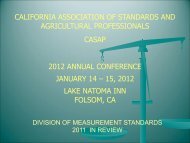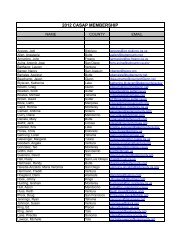California Association of Standards and Agricultural ... - CASAP
California Association of Standards and Agricultural ... - CASAP
California Association of Standards and Agricultural ... - CASAP
You also want an ePaper? Increase the reach of your titles
YUMPU automatically turns print PDFs into web optimized ePapers that Google loves.
<strong>California</strong> <strong>Association</strong> <strong>of</strong> <strong>St<strong>and</strong>ards</strong><br />
<strong>and</strong> <strong>Agricultural</strong> Pr<strong>of</strong>essionals<br />
Chris Reardon<br />
Chief Deputy Director<br />
<strong>California</strong> Department <strong>of</strong> Pesticide Regulation<br />
January 19, 2013
• 2012-13 budget: $82.9 million<br />
DPR Budget Update<br />
• Gov. Brown’s Government Reorganization<br />
Plan<br />
– Structural Pest Control Board transfer to new Business<br />
<strong>and</strong> Consumer Services Agency by July 1, 2013 – 30<br />
employees<br />
• $500,000 annually for grants to research<br />
nonfumigant production practices<br />
– First funding cycle is fiscal year 2012-13<br />
– Up to 10 research projects could be funded<br />
annually for up to 3 years<br />
• New grant program is in addition to<br />
Pest Management Grants, which are<br />
$400,000 annually
DPR Budget Highlights<br />
• 2013-14 Proposed Budget: $81.0 million<br />
384.8 positions.<br />
• Staffing: from February 2009 through June 2013,<br />
DPR employees have been subject to unpaid leave<br />
days through furloughs <strong>and</strong>/or the Personal Leave<br />
Program (PLP), a m<strong>and</strong>atory one-day-per-month<br />
leave. The current PLP is scheduled to end on June<br />
30, 2013.<br />
• Retirements: 42 employees have retired<br />
from DPR since 2010 <strong>and</strong> another 180-plus<br />
are eligible to retire in the next five years--<br />
almost half <strong>of</strong> DPR workforce.<br />
– Environmental Monitoring:<br />
Alfalfa study, Davis.
Existing Situation Requires New Strategies<br />
on Fumigants<br />
• Fumigants are important tool for<br />
farmers<br />
• However, loss <strong>of</strong> methyl iodide, phase<br />
out <strong>of</strong> methyl bromide, more<br />
restrictions on other fumigants <strong>and</strong><br />
continued development<br />
in urban edge require<br />
urgent action by DPR to<br />
identify <strong>and</strong> accelerate<br />
development <strong>of</strong> tools to<br />
control pests without<br />
fumigants
NEW STRATEGIES (continued)<br />
• $500,000 research partnership with <strong>California</strong><br />
Strawberry Commission to grow strawberries<br />
in peat or substances other than soil<br />
– 3-year project building on years <strong>of</strong> research<br />
• 10-member work group <strong>of</strong> scientists to<br />
develop 5-year action plan by late<br />
fall that identifies practical <strong>and</strong><br />
cost-effective ways to grow<br />
strawberries without soil<br />
fumigants
Fumigants Update<br />
• Methyl iodide<br />
– Pulled from U.S. marketplace in March<br />
after six applications in <strong>California</strong><br />
– Arysta LifeScience voluntarily canceled<br />
registration in <strong>California</strong><br />
• Methyl bromide<br />
• Chloropicrin<br />
• U.S. EPA safety<br />
measures
Enforcement Issues<br />
• New surface water regulations, effective July<br />
19<br />
– Limit amount <strong>of</strong> pesticides used <strong>and</strong> where they<br />
can be applied by structural pest control<br />
businesses <strong>and</strong> maintenance gardeners<br />
• Central Coast chlorpyrifos mitigation effort<br />
• Proposed regulations targeting volatile<br />
organic compound (VOC) emissions from<br />
nonfumigant pesticides in San Joaquin Valley<br />
– Fresno, Kings, Madera,<br />
Merced, San Joaquin,<br />
Stanislaus <strong>and</strong> Tulare<br />
counties <strong>and</strong> part <strong>of</strong><br />
Kern
Air Monitoring Network Update<br />
• Launched in February 2011 in:<br />
– Shafter (Kern County); Salinas<br />
(Monterey County); <strong>and</strong> Ripon (San<br />
Joaquin County)<br />
• Sampling ambient air<br />
for nearly three dozen pesticides<br />
next 3 to 5 years<br />
• Pesticides selected based<br />
on amount <strong>of</strong> use <strong>and</strong><br />
potential health risks<br />
• First-year results will be released<br />
tomorrow
Other Key Issues<br />
• Chlorpyrifos<br />
– U.S. EPA’s draft risk assessment<br />
– DPR also working on a risk assessment<br />
<strong>and</strong> coordinating with U.S. EPA<br />
– Significant label restrictions expected<br />
• Pyrethroid reevaluation<br />
– Pyrethroid Working<br />
Group developing<br />
<strong>California</strong>-specific<br />
data
Other Key Issues<br />
• Rodenticides update<br />
– DPR reevaluating rodenticides containing<br />
brodifacoum in response to state<br />
Department <strong>of</strong> Fish <strong>and</strong> Game concerns<br />
that wildlife is being adversely affected<br />
• Pollinator health<br />
– DPR very concerned<br />
about pollinator health<br />
<strong>and</strong> is working with U.S.<br />
EPA <strong>and</strong> other states to<br />
address colony collapse<br />
disorder <strong>and</strong> declining<br />
health <strong>of</strong> pollinators<br />
related to multiple factors
Western Plant Health <strong>Association</strong><br />
Questions?<br />
Also check out our website:<br />
www.cdpr.ca.gov








